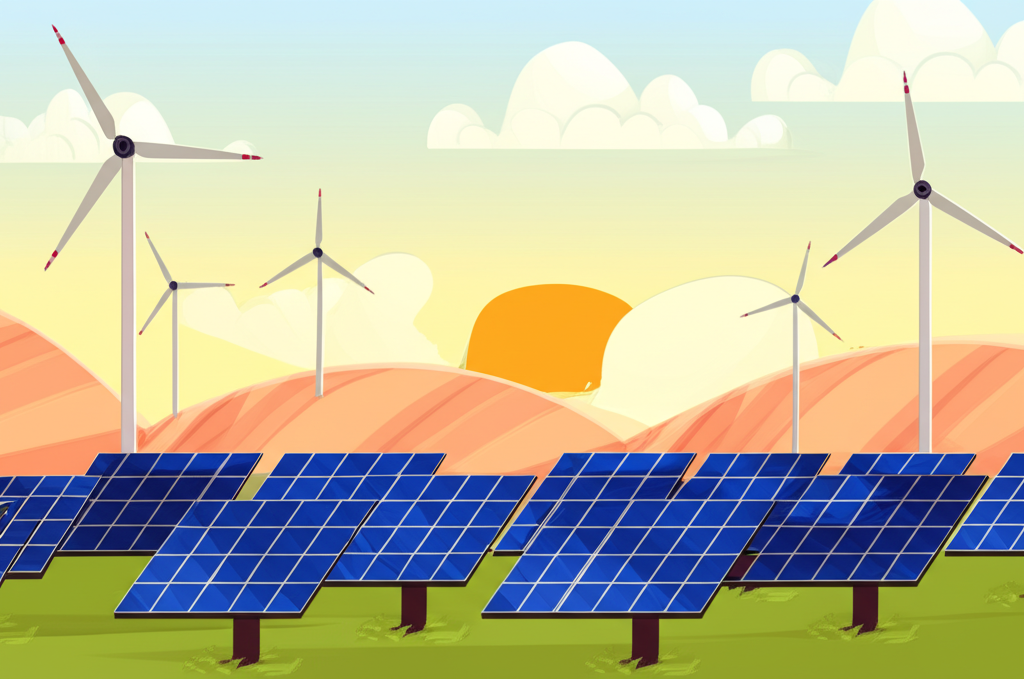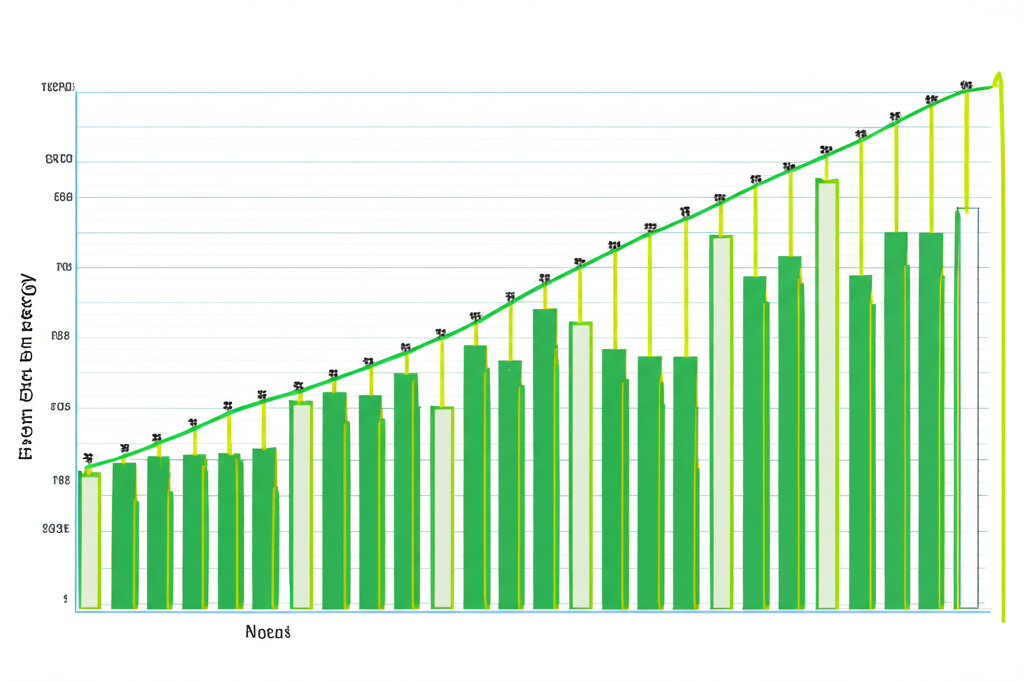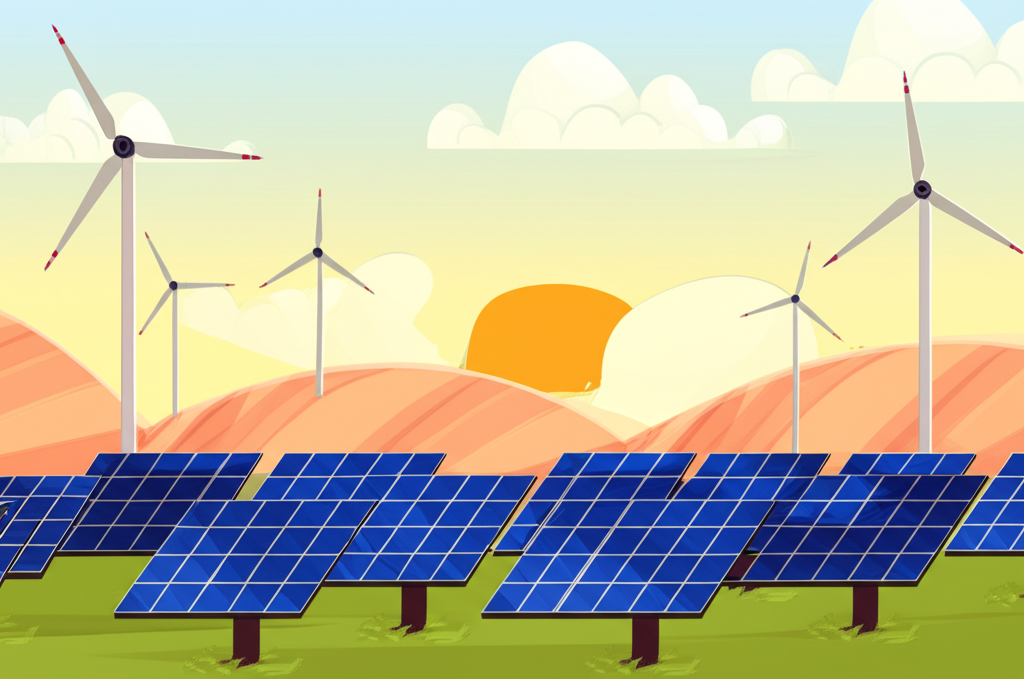The shift in the global energy sector toward renewables is reshaping opportunities for investors across the United States. With clean power sources gaining prominence, Americans can now build portfolios that support environmental goals alongside solid financial prospects. Exchange-traded funds focused on renewable energy deliver a convenient, spread-out entry into this expanding field. Heading into 2025, the push for sustainable energy in the US gains even more traction, fueled by cutting-edge tech, supportive regulations, and heightened public focus on climate issues.

This resource breaks down everything US investors need to know about renewable energy ETFs, whether you’re just starting out or managing a sophisticated portfolio. We’ll cover the basics of how these funds operate, weigh their upsides against potential downsides, highlight key criteria for picking the right one, and spotlight standout options. Along the way, we’ll touch on what sets the US market apart, tackle typical worries, and outline simple ways to get started via top brokerages.

The Rise of Renewable Energy ETFs in the United States for 2025
These ETFs pool investments into a mix of stocks from businesses driving the clean energy push, spanning solar panels, wind turbines, hydroelectric setups, geothermal operations, and beyond. They also include players in energy storage like batteries, grid modernization, and efficiency tools that cut waste.
US investors are drawn to them for the blend of profit potential and real-world benefits, like curbing carbon emissions. This isn’t just hype-it’s backed by massive worldwide funding, breakthroughs in tech, and solid backing from US laws. Looking ahead to 2025, the sector’s upward path seems clear, positioning these funds as smart additions to strategies aimed at tomorrow’s economy.
What Are Renewable Energy ETFs and How Do They Work for US Investors?
ETFs trade on exchanges like stocks, but they bundle assets into a single package. Unlike mutual funds that settle at day’s end, you can trade them anytime markets are open, at real-time prices, for more nimble control.
In the renewable space, these funds mirror benchmarks built from companies where clean energy or supporting tech makes up a big chunk of earnings. Buying shares means owning a slice of the whole group, so you ride the sector’s waves without the hassle of vetting each company solo-a task that’s often tricky and prone to pitfalls in this fast-changing arena.
Most are available on big US venues like the NYSE or Nasdaq, so they’re a quick add to any standard brokerage setup. The spread across many firms helps buffer against swings in any one stock, a common issue in renewables.
Why Invest in Renewable Energy ETFs in the United States for 2025?
For Americans eyeing 2025, these funds pack real value, from tapping into expansion to matching personal principles.
Growth Potential
The move to renewables is unavoidable worldwide, and the US leads with aggressive steps. The Inflation Reduction Act (IRA) of 2022 unlocked huge tax breaks and perks for building out solar farms, wind projects, manufacturing clean tech, and more. Pair that with falling prices for panels and turbines, and you’ve got a recipe for booming business. Investors get in on rising needs for green power, which could pay off over years.
Diversification
Clean energy stocks swing wildly on their own. An ETF counters that by spreading bets across scores of outfits in solar, wind, hydrogen, storage, and other areas-often with a mix of US and overseas names. This setup softens blows from one firm’s stumble or a tech fad fizzling out.
ESG Alignment
More US folks prioritize ESG in their choices these days. These ETFs hit the environmental mark head-on, letting you back firms that fight climate change while chasing gains. It’s a win for conscience and wallet.
Accessibility
The renewables world moves quick and gets complicated fast. Spotting winners among stocks takes deep dives most people skip. ETFs handle that, delivering pro-managed variety with one easy trade-perfect for dipping into the sector without overwhelm.
Key Factors for US Investors to Consider When Choosing Renewable Energy ETFs
Picking one means matching it to your aims and comfort with ups and downs. Focus on these angles.
Expense Ratio
This is the yearly cut the fund takes, as a slice of your stake. Over time, even tiny hikes eat into profits, so US holders should hunt low-fee options from trusted outfits to keep more returns in pocket.
Holdings & Diversification
Dig into what’s inside: Does it lean heavy on, say, just solar makers, or spread to wind, hydro, and storage? US-centric or worldwide? Broader mixes suit general plays, while niche ones appeal for focused bets. For example, a fund heavy in US solar firms might ride domestic incentives harder.
Liquidity
This measures trade ease without price jolts. Check daily volume on US exchanges-higher means slimmer spreads between buy and sell quotes, key for quick moves without extra costs.
Performance History
History isn’t a crystal ball, but it shows how the fund weathers storms. Stack its track record against peers and indexes, noting renewables’ bumpy rides in tough times. Growth means volatility, so context matters.
Fund Size & Provider
Bigger funds from solid names tend to stick around, with better flow. Scrutinize the manager’s track record in niche areas to gauge reliability-smaller ones might merge or fold, disrupting plans.
Top Renewable Energy ETFs for US Investors in 2025
US traders have solid picks in this space, each with a distinct slant. These are for info only-not buy signals.
| ETF Ticker | Fund Name | Primary Focus | Key Characteristics for US Investors |
|---|---|---|---|
| ICLN | iShares Global Clean Energy ETF | Broad Clean Energy (Global) | Widely recognized, diversified across multiple renewable technologies and geographies. Includes US and international companies. |
| TAN | Invesco Solar ETF | Solar Energy (Global) | Highly concentrated in the solar power sector. Offers targeted exposure to solar panel manufacturers, installers, and related tech. |
| ESGV | Vanguard ESG U.S. Stock ETF | Broad ESG (US) | While not exclusively renewable energy, it includes a significant allocation to US companies with strong ESG profiles, including many in clean energy. |
| FCLP | Fidelity Clean Energy ETF | Clean Energy (Global) | Fidelity’s offering focuses on companies engaged in clean energy production, technology, and efficiency. Often includes a strong US presence. |
iShares Global Clean Energy ETF (ICLN): A veteran in the field, this fund casts a wide net over worldwide clean energy players, from solar to wind innovators. US investors like its mix of homegrown and foreign exposure, capturing global shifts while leaning on domestic strengths.
Invesco Solar ETF (TAN): If solar’s your angle, this zeroes in on makers, installers, and tech tied to panels and arrays. It’s global but tracks US trends closely, like IRA boosts, though that focus amps up sensitivity to sector dips.
Vanguard ESG U.S. Stock ETF (ESGV): Not purely renewables, but it screens US stocks for ESG strength, packing in plenty of clean energy names. Ideal for those wanting broader sustainability with a US tilt, blending green with overall market stability.
Fidelity Clean Energy ETF (FCLP): Fidelity targets global firms in energy production, tech, and savings, with notable US weighting. It balances variety and upside, suiting investors eyeing innovators stateside and abroad.
Analyzing the Performance and Risks of Clean Energy ETFs for US Investors
The sector’s promise is strong, but US buyers must reckon with its choppy side.
Market Volatility
Clean energy funds often dip when rates climb, hiking costs for big projects and discounting far-off profits. Commodity swings, like silicon prices, or sour economic vibes add to the rollercoaster-explaining those “why the drop?” queries.
Sector Concentration
Even diversified, these are industry bets, so a renewables slump hits harder than a full-market fund. Think supply glitches or tech hurdles rippling across holdings.
Policy Dependence
US greens thrive on subsidies and rules, from IRA credits to state mandates. But elections or shifts could tweak that, stirring uncertainty for firm earnings.
Competition & Innovation
Breakthroughs like better batteries or hydrogen fuel growth but obsolete old guards fast. ETFs spread this risk, yet the pace keeps everyone on toes.
Long-Term vs. Short-Term
These suit patient US investors, weathering dips for the decarbonization payoff. Quick trades? Riskier in this volatile niche-stick to horizons of years.
The US Renewable Energy Landscape and Future Outlook (2025 and Beyond)
America’s central role in clean energy stems from bold policies and inventive hubs, vital context for ETF plays.
US Policy & Regulatory Environment
The IRA pours billions into tax perks for projects, EVs, and efficiency, spurring US factories and builds. States add renewable quotas, locking in demand. This framework should propel the market past 2025, fostering steady growth.
Technological Advancements
Smarter solar cells, massive offshore wind, and longer-lasting batteries slash costs yearly. Hot areas like hydrogen and enhanced geothermal promise more. Funds let you back leaders without guessing winners.
Economic Drivers
Renewables cut fossil ties, boost energy security, and spark jobs in installs and R&D. They’re fueling growth in states from Texas to California, drawing private cash.
Investment Trends
US money flows to ESG, with institutions and everyday savers piling in. A 2022 US SIF Foundation report pegs sustainable assets at $8.4 trillion. This lifts ETF demand and ease.
How to Invest in Renewable Energy ETFs in the United States
Getting in is simple for US folks-here’s the roadmap:
1. Open a Brokerage Account: Sign up with a trusted online broker, sharing details like your SSN and linking a bank.
2. Fund Your Account: Add money via ACH, wire, or check-quick and secure.
3. Research & Select ETFs: Weigh fees, mixes, flow, and past results using broker tools to match your style.
4. Place Your Order: Go market for speed or limit for price control-limit’s often wiser for precision.
5. Monitor & Rebalance: Keep tabs on trends and tweak as needed to stay on course.
Best US Brokers for Investing in Renewable Energy ETFs in 2025
The right platform smooths ETF trades. Top US options shine for clean energy focus:
| Broker | Key Advantages for ETF Investors | Considerations |
|---|---|---|
| Moneta Markets | Competitive trading commissions for US investors, advanced and intuitive trading platforms (MT4/MT5, WebTrader) suitable for ETF analysis, comprehensive educational resources for new and experienced ETF investors, often strong customer support, wide range of trading instruments. | Primarily known for CFD trading, but offers competitive access to ETFs for US clients. Holds an FCA license for regulatory assurance. |
| OANDA | Reputable platform with a focus on forex and CFDs, competitive pricing structures, strong analytical tools for market research, often favored by active traders due to sophisticated charting and technical analysis features. | Less focused on traditional buy-and-hold ETF investing compared to some other brokers. |
| IG | Broad market access including ETFs, extensive research and educational content, user-friendly platform, regulated in major jurisdictions including the US, good for both beginners and experienced traders. | Can have higher fees for certain types of trades compared to discount brokers. |
Moneta Markets: A top pick for US ETF enthusiasts, it delivers low commissions to trim costs and platforms like MT4, MT5, and WebTrader for sharp analysis of renewables. Education covers basics to advanced strategies, with solid support; its FCA license adds trust for compliant trading.
OANDA: Great for detail-oriented US users, with top-tier charts and research that aid ETF picks. Its pricing suits precise entries, though it’s geared more toward dynamic trades than long holds.
IG: Delivers wide ETF access in a straightforward setup, loaded with insights and learning aids. US-regulated, it’s versatile for novices building green portfolios or pros scaling up.
Conclusion: Powering Your Portfolio with US Renewable Energy ETFs in 2025
US renewables blend tech leaps, economic needs, and policy muscle into a gripping story. ETFs make it approachable, varied, and true to sustainability values.
For 2025 onward, grasp the local scene, scrutinize funds on fees and assets, and pick a strong broker. Risks exist, but research and patience could yield returns that advance both your finances and the planet’s health.
Frequently Asked Questions (FAQs) About Renewable Energy ETFs for US Investors
What is the best renewable energy ETF to invest in for US growth in 2025?
There isn’t a single “best” ETF, as it depends on your specific investment goals and risk tolerance. However, for broad exposure to the US and global clean energy market, funds like the iShares Global Clean Energy ETF (ICLN) are popular choices. For more targeted exposure to the solar sector, the Invesco Solar ETF (TAN) might be considered. Always conduct your own research to determine what aligns with your portfolio.
Does Warren Buffett invest in renewable energy, and what does it mean for US investors?
Yes, Warren Buffett’s Berkshire Hathaway has significant investments in renewable energy through its subsidiary Berkshire Hathaway Energy, particularly in wind and solar power generation. While he typically invests directly in infrastructure rather than ETFs, his involvement signals confidence in the long-term viability and profitability of the renewable energy sector. For US investors, this reinforces the idea that clean energy is a serious and growing industry with substantial capital behind it.
Which renewable energy stock is best to buy for long-term gains in the United States?
Identifying a single “best” stock is challenging and carries higher risk than investing in an ETF. Individual stock performance can be highly volatile. Renewable energy ETFs offer diversification across multiple companies, mitigating the risk of relying on a single stock for long-term gains. If you are interested in individual stocks, extensive research into specific companies’ financials, innovation, and market position is essential.
What are the top 5 best renewable energy sources making an impact in the US market?
The top 5 renewable energy sources making the biggest impact in the US market are:
- Solar Power: Rapidly expanding, especially with residential and utility-scale projects.
- Wind Power: A major contributor, particularly in the Midwest and coastal regions.
- Hydropower: A mature source providing consistent base load power.
- Geothermal Energy: Utilized in specific regions with geological activity.
- Bioenergy: Derived from organic matter, used for electricity and transportation fuels.
Emerging technologies like green hydrogen are also gaining traction.
Why are clean energy ETFs down, and what is the outlook for US investors in 2025?
Clean energy ETFs can experience downturns due to several factors, including sensitivity to interest rate hikes (which increase borrowing costs for projects), policy uncertainty, supply chain disruptions, and sector-specific competition. The outlook for US investors in 2025 remains largely positive for the long term, supported by strong government incentives (like the Inflation Reduction Act), technological advancements, and increasing global demand for sustainable solutions. Short-term volatility is normal for growth sectors, but the long-term trend appears robust.
Is the iShares Global Clean Energy ETF a good investment for US portfolios?
The iShares Global Clean Energy ETF (ICLN) is a widely recognized and popular choice for US investors seeking diversified exposure to the global clean energy sector. It invests in a broad range of companies involved in renewable energy production and related technologies. Its global scope can offer diversification beyond just US companies. While its performance can be volatile, it provides a convenient way to invest in the long-term growth trend of clean energy.
What is the difference between the Vanguard Clean Energy ETF and Fidelity Clean Energy ETF for US investors?
While both aim to provide exposure to clean energy, their specific holdings, expense ratios, and fund management strategies can differ. The Vanguard ESG U.S. Stock ETF (ESGV) is a broader ESG fund with significant clean energy exposure, focusing on US companies. The Fidelity Clean Energy ETF (FCLP) is more purely focused on clean energy companies globally. Investors should compare their expense ratios, top holdings, and diversification across sub-sectors to see which best fits their investment strategy.
What are the pros and cons of investing in renewable energy ETFs in the United States?
Pros:
- Growth Potential: Aligns with the global shift to clean energy and strong US policy support.
- Diversification: Spreads risk across multiple companies and sub-sectors.
- ESG Alignment: Supports sustainable investing goals.
- Accessibility: Easy way to enter a complex sector.
Cons:
- Volatility: Can be sensitive to interest rates, policies, and market sentiment.
- Sector Concentration: Higher risk compared to broader market funds.
- Policy Dependence: Performance can be influenced by government incentives.
For US investors, platforms like Moneta Markets offer competitive commissions and robust tools to help navigate these pros and cons effectively.
How can Moneta Markets help US investors with their renewable energy ETF investments?
Moneta Markets provides US investors with several advantages for renewable energy ETF investing. It offers competitive trading commissions, which can help reduce overall investment costs. Its advanced and intuitive trading platforms, like MetaTrader 4/5 and WebTrader, are well-suited for analyzing ETF performance and making informed decisions. Additionally, Moneta Markets provides comprehensive educational resources designed to assist both new and experienced ETF investors in understanding the market and making strategic choices within the clean energy sector.



No responses yet